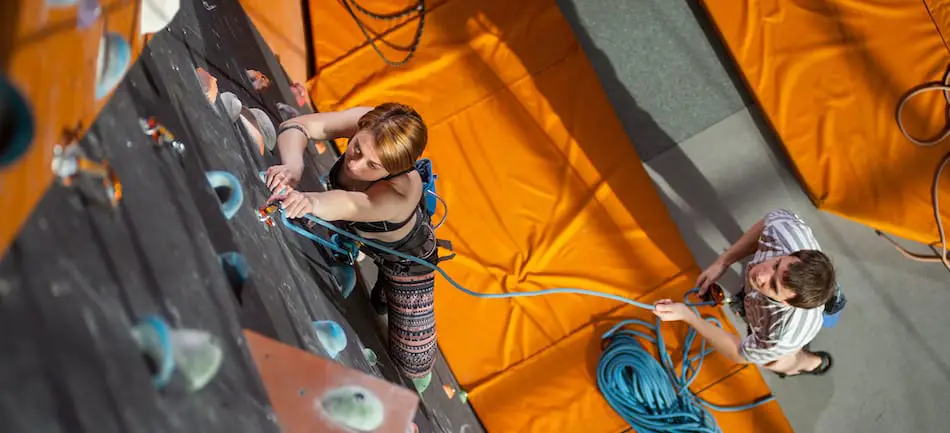
Buying all the gear to try out a new sport can be difficult. I’ve written the following guide to teach you everything you need to know about how expensive rock climbing is?
So, is rock climbing expensive? Rock climbing is moderately expensive. To try rock climbing once, you’ll have to spend about $30. Getting into the sport full-time will cost about $500 in gear and $80 per month in gym fees.
As sports go, rock climbing is probably middle-of-the-road in terms of how expensive it is. If you just want to try it out at your local gym and see how you like it, you’ll likely have to spend around $20-$30 on a single day pass and another $10 if you decide to rent shoes, a harness, and/or a chalk back. If you want to start climbing more frequently, you can expect to have to spend around $250 in gear to get all of the basics, as well as paying a monthly membership fee.
Rock Climbing Expenses

Wondering where your money goes in rock climbing? The basic gear you’ll need to buy includes:
- Shoes ($100)
- Harness ($60)
- Chalk bag ($30)
- Belay device ($50-$150)
This is the minimum gear that you need to be able to climb at any climbing gym. Of course, you could trim this list down even more by ditching the harness and belay device, but this would limit the number of routes you could climb (without those pieces, you’ll be confined to bouldering routes).
Shoes
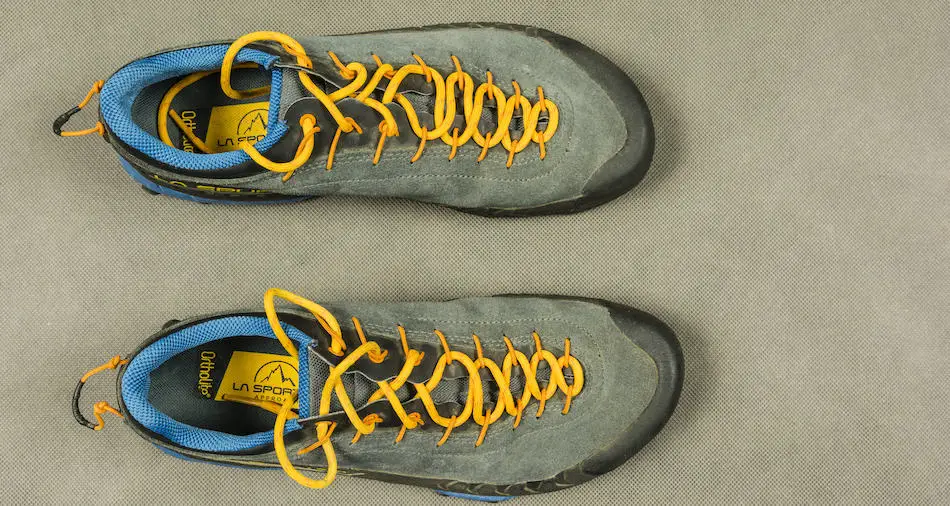
What they’re for: Letting your toes grip small holds
How much they cost: $100 for a beginner pair; $200+ for an advanced pair
Best for beginners: The La Sportiva Finale
Rock climbing shoes are the narrow, rubber-heavy pieces of footwear that you’ve probably seen on the feet of any climber you’ve watched. They’re designed specifically to allow your feet to gain purchase on small footholds.
Climbing shoes are probably the first major purchase that any new climber makes. While they’re decently expensive, they’re not exactly prohibitive. I know a friend who only climbs a couple of times a year and he still has his own pair of shoes.
If you have any interest at all in climbing, shoes should be the first thing you buy.
There’s a massive variety of shoes out there, ranging from super-downturned, ultra-aggressive ones to softer, slipper-like pairs. If you’re just getting into the sport, you want something that’s gentle on your feet but still stiff enough to give you a bit of support on the route.
Enter the La Sportiva Finale. I’ve been climbing in these shoes for four years now, and I cannot recommend them enough. They’re comfortable, well-designed, and technical enough to stay with you as you begin progressing into higher grades.
Their laced finish means you can adjust how tightly they fit, while the tension rands on the heel mean that your foot will stay firmly in place. The lacing can be a big of a downside, because it means you have to spend more time taking them on and off, but the Finale’s are comfortable enough that you don’t have to worry too much about that.
Harness
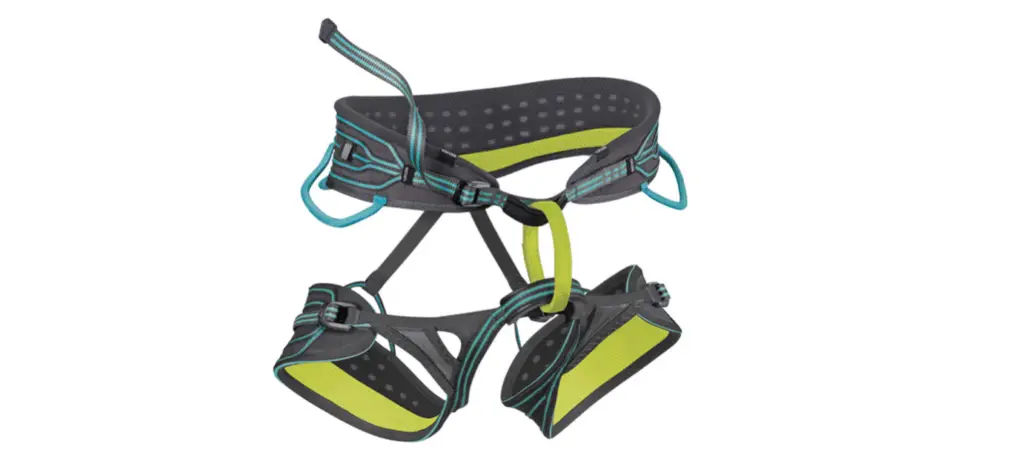
What it’s for: Allowing you to climb ‘top rope’, or routes that aren’t boulders
How much it costs: Around $60 for a beginner harness
Best for beginners: The Black Diamond Momentum is the go-to for most people (including myself)
If you want to do anything more than bouldering, you’ll need a harness. A harness is used to tie yourself into a rope that catches you if you fall; this allows you to climb higher than 10 feet off the ground.
For your first harness, I wouldn’t look for anything fancy. High-end climbers and mountaineers might worry about weight, comfort, or features, but you really just need something to keep you in place.
I’ve been using my Black Diamond Momentum for 5 years now, and it’s served me well for gym climbing, outdoor climbing, ice climbing, and multi-pitch routes. It’s not the best harness for each scenario, but it functions just fine. It’s decently comfortable and very affordable, and that’s really all you need.
Chalk bag
What it’s for: Holding your chalk
How much it costs: $30
Best for beginners: Anything from Black Diamond, Mammut, or other climbing brands.
You don’t have to get fancy when looking for your chalk bag. Again, I’ve had the same one for 5 years now, and it’s served me well everywhere that I’ve gone.
There are some fancier bags out there that have pouches for your keys and other small items. These are designed for things like multipitch routes, but I’m not really a huge fan of them; they’re pretty pointless in the gym, and I’ve heard too many stories of people unbuckling their bag by accident mid-route.
Belay Device
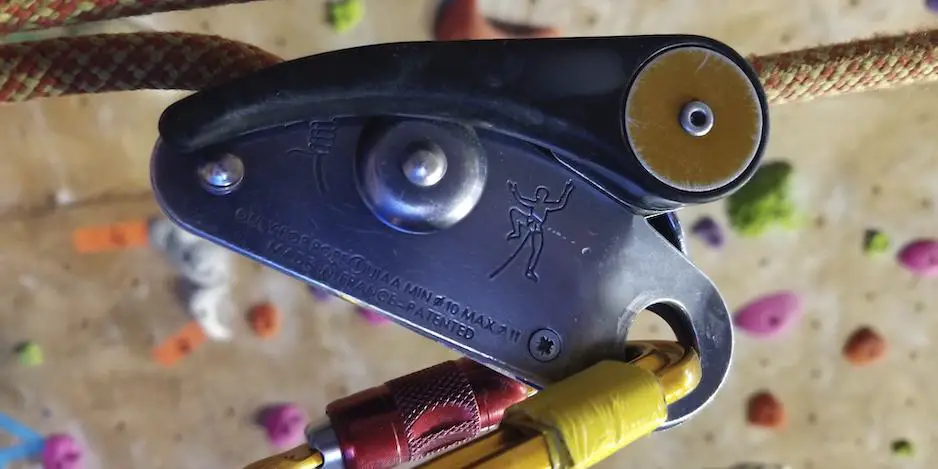
What it’s for: Catching your climbing partner when they’re tied into a rope
How much it costs: The gri-gri costs about $110
Best for beginners: The Petzl gri gri
If you want to climb top rope (e.g., use your harness at all), you need to have a partner with a belay device. This means that you’ll have to belay them in turn, meaning that you’ll need a belay device.
There’s a wide variety of belay devices out there for a lot of different uses. The ATC Guide is an all-time classic that every serious climber should own. The Edelrid Mega and Gig-Jul are cool new entries onto the scene that definitely have some promise, but the best belay device out there is still the Petzl gri gri.
The gri gri is intuitive, easy to use, and super secure. Its auto-locking feature means that you can afford to make a mistake here and there without dropping your partner. What’s more, the gri gri is so common that almost any gym or climber will have one, meaning you’ll be familiar with it if you ever have to borrow one.
Additional Gear
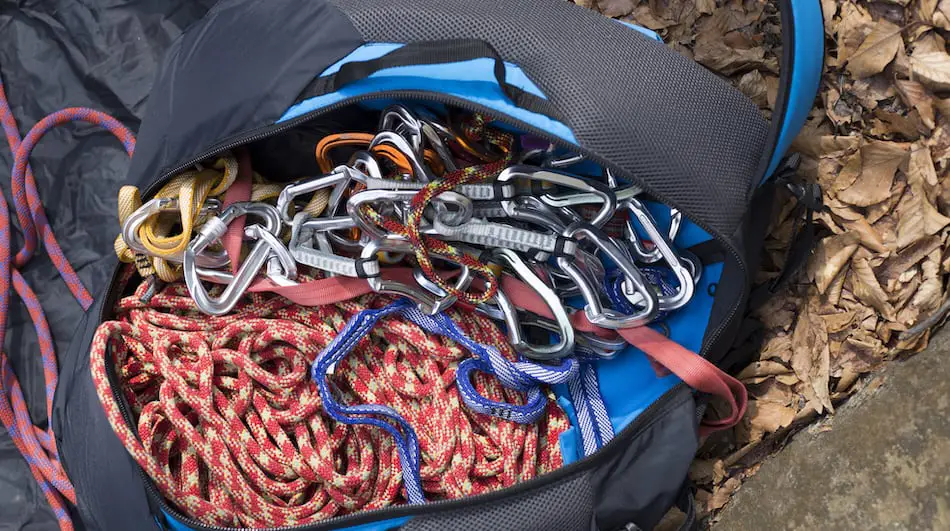
So, that covers the bare necessities of gear you’ll need to spend if you want to climb semi-regularly and not have to rent or borrow gear.
With that being said, though, there’s a long list of other gear that you’ll need/want as you start getting more into the sport. I don’t know any climber who’s been able to get away with spending only $300 on gear.
The more involved you get, the more stuff you need. Fortunately, getting more into climbing also means needing to learn new skills, which takes time. It’s easy to spend your climbing over the course of several years.
More Shoes!
Basically every serious climber I know has more than one pair of shoes; many have 3-4 that they rotate through depending on what route they’re on. You might want a super aggressive pair for overhung routes, a comfortable pair for long multi-pitch, and a stiff pair for slabby trad routes.
While it’s not necessary to have more than one pair — lots of people get by with just one — it can definitely help. I personally have two pair (one comfortable, one more technical) and will likely need to get more as I get more into the sport.
If you need a good everything shoe, I would look at the Scarpa Vapors.
Rope
If you want to climb outdoors, a rope is a must. Ropes can cost between $150-$300, and you need to replace them every couple of years to make sure that yours isn’t wearing out (you trust it with your life, you want to make sure it’s in good quality).
What rope you want depends on what you’re using it for. For most climbers, a 9.8mm rope from somewhere like Mammut, Sterling, or Black Diamond will work well in just about every situation that you’ll want.
Trad Rack
A trad rack is the really big investment that you’ll make. The jump from sport climbing to trad climbing is a big one in both skill and money; a full trad rack can cost anywhere up to $5,000, so you need to be really committed to the game before you do this.
Don’t let this intimidate you, though; many people spend their entire lives climbing without ever having to spend $5,000 on gear, so this certainly isn’t necessary.
